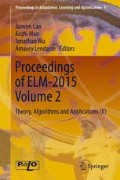Abstract
In recent years there has been a considerable interest in exploring the nature of learning and memory system among artificial intelligence researchers and neuroscientists about the neural mechanisms, simulation and enhancement. While a number of studies have investigated the artificial neural networks inspired by biological learning and memory systems, for example the extreme learning machine and support vector machine, seldom research exists examining and comparing the recording neural data and these neural networks. Therefore, the purpose of this exploratory qualitative study is to investigate the extreme learning machine proposed by Huang as a novel method to analyze and explain the biological learning process in the entorhinal hippocampal system, which is thought to play an important role in animal learning, memory and spatial navigation. Data collected from multiunit recordings of different rat hippocampal regions in multiple behavioral tasks was used to analyze the relationship between the extreme learning machine and the biological learning. The results demonstrated that there was a correlation between the biological learning and the extreme learning machine which can contribute to a better understanding of biological learning mechanism.
Access this chapter
Tax calculation will be finalised at checkout
Purchases are for personal use only
References
Hartley, T., Lever, C., Burgess, N., O’Keefe, J.: Space in the brain: how the hippocampal formation supports spatial cognition. Philos. Trans. Roy. Soc. Lond. B: Biol. Sci. 369(1635), 20120510 (2014)
Su, L., Zhang, N., Yao, M., Wu, Z.: A computational model of the hybrid bio-machine mpms for ratbots navigation. IEEE Intell. Syst. 29(6), 5–13 (2014)
Zheng, N., Su, L., Zhang, D., Gao, L., Yao, M., Wu, Z.: A computational model for ratbot locomotion based on cyborg intelligence. Neurocomputing 170, 92–97 (2015)
Yamaguchi, Y., Sato, N., Wagatsuma, H., Wu, Z., Molter, C., Aota, Y.: A unified view of theta-phase coding in the entorhinal-hippocampal system. Curr. Opin. Neurobiol. 17(2), 197–204 (2007)
Huang, G.B., Zhu, Q.Y., Siew, C.K.: Extreme learning machine: a new learning scheme of feedforward neural networks. In: 2004 IEEE International Joint Conference on Neural Networks. Proceedings, vol. 2, pp. 985–990. IEEE (2004)
Huang, G.B., Wang, D.H., Lan, Y.: Extreme learning machines: a survey. Int. J. Mach. Learn. Cybern. 2(2), 107–122 (2011)
Huang, G.B.: What are extreme learning machines? Filling the gap between frank rosenblatts dream and john von neumanns puzzle. Cogn. Comput. 7(3), 263–278 (2015)
Huang, G.B., Zhu, Q.Y., Siew, C.K.: Extreme learning machine: theory and applications. Neurocomputing 70(1), 489–501 (2006)
Gluck, M.A., Meeter, M., Myers, C.E.: Computational models of the hippocampal region: linking incremental learning and episodic memory. Trends Cogn. Sci. 7(6), 269–276 (2003)
Deshmukh, S.S., Knierim, J.J.: Representation of non-spatial and spatial information in the lateral entorhinal cortex. Front. Behav. Neurosci. 5 (2011)
Mizuseki, K., Sirota, A., Pastalkova, E., Buzsáki, G.: Theta oscillations provide temporal windows for local circuit computation in the entorhinal-hippocampal loop. Neuron 64(2), 267–280 (2009)
Diba, K., Buzsáki, G.: Hippocampal network dynamics constrain the time lag between pyramidal cells across modified environments. J. Neurosci. 28(50), 13448–13456 (2008)
Deuker, L., Doeller, C.F., Fell, J., Axmacher, N.: Human neuroimaging studies on the hippocampal ca3 region—integrating evidence for pattern separation and completion. Front. Cellular Neurosci. 8 (2014)
Mizuseki, K., Diba, K., Pastalkova, E., Teeters, J., Sirota, A., Buzsáki, G.: Neurosharing: large-scale data sets (spike, lfp) recorded from the hippocampal-entorhinal system in behaving rats. F1000Research 3 (2014)
Klauke, N., Smith, G.L., Cooper, J.: Extracellular recordings of field potentials from single cardiomyocytes. Biophys. J. 91(7), 2543–2551 (2006)
Buzsáki, G., Anastassiou, C.A., Koch, C.: The origin of extracellular fields and currentseeg, ecog, lfp and spikes. Nat. Rev. Neurosci. 13(6), 407–420 (2012)
Gold, C., Henze, D.A., Koch, C., Buzsáki, G.: On the origin of the extracellular action potential waveform: a modeling study. J. Neurophysiol. 95(5), 3113–3128 (2006)
Belitski, A., Gretton, A., Magri, C., Murayama, Y., Montemurro, M.A., Logothetis, N.K., Panzeri, S.: Low-frequency local field potentials and spikes in primary visual cortex convey independent visual information. J. Neurosci. 28(22), 5696–5709 (2008)
Quilichini, P., Sirota, A., Buzsáki, G.: Intrinsic circuit organization and theta-gamma oscillation dynamics in the entorhinal cortex of the rat. J. Neurosci. 30(33), 11128–11142 (2010)
Huang, G., Huang, G.B., Song, S., You, K.: Trends in extreme learning machines: a review. Neural Netw. 61, 32–48 (2015)
Lekamalage, C.K.L., Liu, T., Yang, Y., Lin, Z., Huang, G.B.: Extreme learning machine for clustering. In: Proceedings of ELM-2014, vol. 1, pp. 435–444. Springer, Berlin (2015)
Einevoll, G.T., Kayser, C., Logothetis, N.K., Panzeri, S.: Modelling and analysis of local field potentials for studying the function of cortical circuits. Nat. Rev. Neurosci. 14(11), 770–785 (2013)
Zanos, T.P., Mineault, P.J., Pack, C.C.: Removal of spurious correlations between spikes and local field potentials. J. Neurophysiol. 105(1), 474–486 (2011)
Mazzoni, A., Logothetis, N.K., Panzeri, S.: The information content of local field potentials: experiments and models. arXiv preprint arXiv:1206.0560 (2012)
Huang, G.B.: An insight into extreme learning machines: random neurons, random features and kernels. Cogn. Comput. 6(3), 376–390 (2014)
Huang, G.B., Bai, Z., Kasun, L.L.C., Vong, C.M.: Local receptive fields based extreme learning machine. IEEE Comput. Intell. Mag. 10(2), 18–29 (2015)
Acknowledgments
This work was supported by the National Key Basic Research Program of China (973 program, No. 2013CB329504) and partially supported by Zhejiang Provincial Natural Science Foundation of China (No. LZ14F020002) and the Natural Science Foundation of China (No. 61103185, No. 61572433 and No. 61472283).
Author information
Authors and Affiliations
Corresponding author
Editor information
Editors and Affiliations
Rights and permissions
Copyright information
© 2016 Springer International Publishing Switzerland
About this paper
Cite this paper
Su, L., Yao, M., Zheng, N., Wu, Z. (2016). Correlation Between Extreme Learning Machine and Entorhinal Hippocampal System. In: Cao, J., Mao, K., Wu, J., Lendasse, A. (eds) Proceedings of ELM-2015 Volume 2. Proceedings in Adaptation, Learning and Optimization, vol 7. Springer, Cham. https://doi.org/10.1007/978-3-319-28373-9_26
Download citation
DOI: https://doi.org/10.1007/978-3-319-28373-9_26
Published:
Publisher Name: Springer, Cham
Print ISBN: 978-3-319-28372-2
Online ISBN: 978-3-319-28373-9
eBook Packages: EngineeringEngineering (R0)

